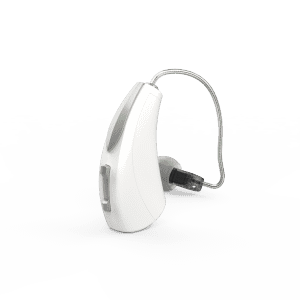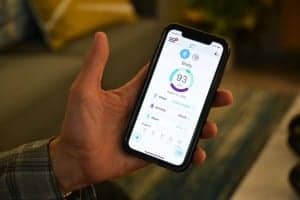Blog | Starkey Livio AI launch

Starkey President Brandon Sawalich kicks off the Livio AI product launch at the company’s headquarters in Eden Prairie, Minn.
On Monday, August 27, at a raucous event that sometimes resembled more of a rock concert than a product introduction, Starkey Hearing Technologies employees and guests celebrated the official launch of Livio AI, a multipurpose sensor-driven hearing aid that Starkey’s CTO and EVP of Engineering Achin Bhowmik, PhD, compares to the iPhone in terms of its potential for reinventing hearing aids.
The new Livio AI contains several firsts and is designed as a multifunctional device, or what Starkey is calling a “Healthable™” hearing technology. These new functions include fall-detection and inertial sensors, fitness and wellness tracking using a “brain and body score,” a real-time language translator, and the ability to control the aid just by tapping it. The “ecosystem” that makes up the the new device is said to revolve around:
- Artificial intelligence (AI);
- Machine learning;
- Cloud computing;
- Embedded 3D motion sensors;
- Telehealth;
- Language translation;
- Fall detection and alerts, and
- Hearing aid accessories.
“Today, we made the impossible possible,” said Starkey President Brandon Sawalich in his opening remarks at the launch. “We’re going to start looking forward…Our capacity is limitless, and we’re going to change the conversation on hearing aids for people. We’re going to make hearing aids cool.”
1) A next-generation hearing aid platform. Although great interest may be drawn to the newest features, Sawalich, Bhowmik, and Starkey staff members were keen to emphasize in discussions with The Hearing Review that—first and foremost—Livio AI is a high-performance hearing aid designed to address hearing loss with the best sound processing available to date from the company. Not to be lost in all the sensor-driven features are the hearing-related innovations. Livio AI debuts Starkey’s new Hearing Reality™ technology that reportedly provides an average of 50% more satisfaction in noisy environments, enhanced clarity of speech, and reduced listening effort and cognitive load through its processing and use of AI. It also uses a dual-radio (2.4 GHz and NFMI) technology for extremely clean and energy-efficient transmission of wirelessly streamed audio. Additionally, Livio AI provides for new customizable and portable teleprogramming solutions for both the user and dispensing professional. Finally, the product offers both Apple and Android compatibility (click here for details) for its TV listening and remote mic accessory devices.
But…having said that, it’s hard not to swivel your head at the other features not previously found in hearing aids. Features #2 through #4 below involve the use of inertial sensors in combination with AI:

David Fabry checks the Thrive health and wellness tracking app which draws its data from the embedded motion sensors in the Livio AI hearing aid he is wearing.
2) Health and wellness tracking app. Billed as a groundbreaking hearing, body, and brain fitness tracker, the new Thrive health and wellness app is designed to track steps and physical activity much like other fitness trackers, while also keeping tabs on “brain health” by noting the amount of time the user spends in conversation and in various acoustic environments.
Starkey Chief Innovation Officer David Fabry, PhD, characterizes this as the gamification of overall physical and brain work, challenging individuals to reach new goals. He says people familiar with a fitness tracker will feel right at home with the Thrive app. The new app rates a person’s overall physical and brain activity on a scale of 0 to 200, with 100 points based on physical activity (ie, steps taken, monitored by the inertial sensor) and the other 100 points based on communication (ie, speech sounds and communication environments, monitored by the hearing aid processor). The fitness tracker updates data every 20 seconds and provides a body-worn measurement of physical activity—so you no longer need to be wearing a wristband or carrying a cellphone to “get credit” for exercise (ie, sometimes leading to what Fabry jokingly calls “step regret”). The default goal is 30 minutes of brisk activity per day, although goals can be customized by the user. The feature also includes a “move” function that reminds you to move if you’ve been inactive for too long. For the “brain fitness” score in the app, 40 of the 100 points are based simply on the goal of wearing the hearing aid for 12 hours a day or more, while 60 points are based on time spent listening to a human voice and moving around in various acoustic environments.“Starkey uses ‘Hear better, live better’ as our mantra,” said Fabry. “We’re looking at the issues that are facing individuals with untreated hearing loss in the aging population and the cognitive decline that comes with that. What we’re looking [to do is assist patients] with the use of hearing aids that are properly fitted to their hearing loss and ensure that they’re using them on a daily basis.”
Bhowmik says there were 15 million fitness trackers sold worldwide last year—5 times the number of hearing aids sold in the United States in 2017 (a figure that stands out even more if one considers binaural usage).
3) Fall detection and alerts. In what may be the most important sensor-driven feature offered, the Livio AI reportedly provides a system to detect a fall. The statistics on the societal and healthcare costs related to falls in the elderly are eye-popping—some $50 billion in associated costs in the United States in 2015 alone. Although the company didn’t address the prevention of falls, it’s not difficult to envision the usefulness of an ear-level monitoring system that could be used to assess postural instability and/or provide an alert immediately upon detecting a fall.

Bill and Tani Austin, who were on a Starkey Hearing Aid Foundation mission in Madagascar, joined the event via Skype to thank employees for their dedication and hard work in developing Livio AI.
4) Command of the hearing aid by tapping on the aid. The human-machine interface with computers has evolved from using the keyboard, to the mouse, and now includes various touch-screen commands, says Fabry. He says the new Livio AI device can turn on or off the remote mic or the new TV listening accessories by simply tapping the side of the hearing aid.
5) Ear-worn language translator. The language translator feature uses cloud-based information to translate up to 27 different languages, says Bhowmik. He explained that, with this feature, the hearing aid is used as an acoustic sensor, the phone as a gateway transmitter, and the cloud as the language processor with its gigawatts of power to decode and interpret words. The company reports that the translation is as good as any translation software on the market. Importantly, with future refinements in technology, the app could ultimately be used as a real-time “captioning device” to supplement the hearing aid user’s speech comprehension. However, its processing is dependent on the server/network connection speed. “[But] it’s going to get better because the whole world is investing tens of billions of dollars there, and we’re partnering with the best in the world,” said Bhowmik. “So you’ll see this as just a start, and it will get better and better.”
Bhowmik, who has a distinguished track record in technology development and was formerly the VP of perceptual computing at Intel, says Livio AI is the most exciting product launch he has ever been involved in. He is quick to point out that, at the product’s core, is AI—a technology that is changing the world and can bring new benefits to hearing-impaired patients that were previously impossible to address. He believes we are on the cusp of a product revolution.
“Looking back to the hearing industry history first, hearing aids have been reinvented before,” says Bhowmik. “Over the last 30-plus years, hearing aids have gone from these big body-worn devices to these really amazing, small, compact devices that you can wear all day…Now we’re taking another step. Because as good as these devices have been, they remain a single-purpose device. It does only one thing…that is to amplify the sound to help people hear better. I compare [this history] to the journey that phones have gone through in the past. You take the phones of the 50s, 60s, and 70s—big ugly phones—and then phones entered a mobile revolution where they became small and you could carry them around. But phones didn’t stop there, right?…No, they took one more step. In June 2007, with the introduction of the iPhone and the Android phones that followed, they took a single-purpose device that was truly useful to you and turned it into a multipurpose device [that does almost everything]…What has this done to that business? 2007 ended with 160 million smart phones sold. [Ten years later], it went to 1.6 billion phones per year, so the volume of phones that were bought [increased by] 10 times in 10 years.” Bhowmik points out that the current worldwide market for hearing aids is about 16 million units. He asks who wouldn’t like to see that volume increase 10-fold by transforming hearing aids into more useful and desirable products.
Starkey executives were candid in noting that this is a first-generation product relative to some of the the sensor/AI/cloud-based features—features that will continue to evolve in quality, complexity, and utility through upgrades and new versions. Additionally, different types of sensors could be employed in the future, opening up new avenues in hearing healthcare and consumer interest. However, Starkey was careful to reinforced the importance of what might seem, by comparison, the more traditional hearing aid improvements in the Livio AI, including its sound quality, performance, noise reduction and speech processing, remote programming, wireless capabilities, and accessories.
But the new Livio AI is an ambitious start to what may be a new era of multi-function sensor- and AI-driven hearing aids—or “Healthables” to use Starkey’s description.
“This is what we dreamed about for so long, and we really are realizing it now thanks to the team,” said Starkey Founder and CEO Bill Austin via Skype from Madagascar, where he and wife Tani were on a hearing care mission with the Starkey Hearing Foundation. “Everybody working together, incredible leadership by Achin in engineering, and we’re finally bringing hearing aids that will help people live longer, be healthier, and perform to task better. [These hearing aids] are really brain assistants. And that was the vision: that we wouldn’t be selling hearing aids in the future (which is now); we’d be helping people live better lives by giving better inputs into our ‘personal computers’, our brains.”
You can watch the full 45-minute product launch here. The Livio AI is available in the United States and Canada, with a global rollout to more than 20 countries in 2019. It is currently available as a RIC 312 and BTE 13 in a variety of colors. For more information, visit the Starkey Livio AI web page.
Karl Strom is editor in chief of The Hearing Review and has been reporting on hearing healthcare issues for nearly 25 years.







When will the new Livio AI be able to monitor heart rate?
Will the 2018 model be able to take advantage of technology advancements gained in future years, or will I need to purchase a newer model then.
When will blood pressure and heart rate monitoring become available for the 2018 Livio AI?
Thank you
SAM